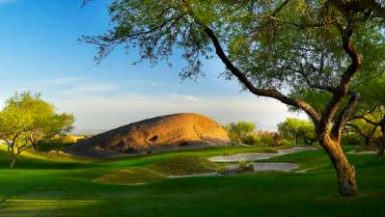
WE-KO-PA GOLF CLUB
18200 East Toh Vee Circle
Fort McDowell, AZ 85264
www.wekopa.com
480.836.9000
Architect: Scott Miller
Par 72
Excitement Level – 10/12
Difficulty – 4/12 White, 7/12 others
Conditioning – Four and 1/2 stars
Cost – $195 peak, $135 reduced
Value – Four to Four 1/2 stars (seasonal)
Design – Four and 1/2 stars
Overall – Four and 1/2 stars
Tees Ydg Rating Slope
Tournament 7225 73.0 136
Back 6740 70.0 131
Middle 6114 67.5 121
Forward 5289 69.9 119
Try to make your woman match your move,
and I’m sharin’ in the We-ko-pa (Weekopaug) groove…
– Phish
Somehow, the fantastic design at We-ko-pa Golf Club outside Scottsdale flies under the radar despite being ranked as high as #38 in the U.S. for public courses by Golf Magazine. Maybe it’s because people need to feel like they have to patronize a huge resort like The Boulders or a former tour facility like Grayhawk when in Scottsdale. Maybe it’s because Troon North’s reputation as “king of the kitty litter courses” (as George Peper calls desert courses) still dominates the landscape. But the secret about We-ko-pa is begining to spread – and it is more than ready for its closeup.
The Yavapai Indian Nation, owners of the We-ko-pa Golf Club in the Fort McDowell Region of Scottsdale had the courage to think out of the box for a resort and embrace one of the wisest trends in the golf industry…spend less money and move less earth and get a better golf course.
We-ko-pa (Yavapai for “Four Peaks,” the name of a nearby mountain range) is not just another pretty course in the desert. Scott Miller has produced his most daring and interesting work to date. While not entirely “minimalist” like it’s more well known neighbor Talking Stick, Miller used the dry washes present on the site as the bulk of the course’s risk reward options. Remember, like wetlands back east, dry washes in the desert may not be excavated, nor built up because they are the primary way for water to travel on the property. Once the Army Corps of Engineers (or whoever was responsible in this instance), marked off the “zona rojos” (red zones – my term for places an architect cannot touch) on Miller’s topo map, he could turn the map into a jigsaw puzzle and wove the course in out and around these areas.
The result shows particular skill and gracefulness. Miller fully employs Alistair Mackenzie’s concept of creating a “line of charm.” This means that on many holes, there is some peril in the direct line of flight between the tee box and the ball, whether a bunker or a stately specimen Saguaro Cactus. Fairways can be as wide as 80 yards, offering multiple angles of play both to the left or right…or you can try to pound one over the hazard or lay up short. As the widest desert course yet built, Miller empowers the golfer to dictate his own method of attack or to use the rope he hands you to hang yourself by being tempted into a shot you can’t execute. Miller also employs optical illusions, frequently placing bunkers 30 yards short of the green, but giving them the appearance from the fairway of being greenside. Further, in high season, the bunkers are not overseeded so their collars have an attractive golden hue, offering a contrast in color and texture.
ON THE COURSE
Miller grabs you right out of the gate with a fantastic diagonal cross hazard to carry off the first tee. Bite off more of the hazard to get closer to the green and have a better angle of approach. The first green has severe undulations and is a true assessment of the rest of the day’s challenge.
The course has remarkable consistency throughout. There are moments where being on the wrong side of the fairway will result in a semi blind approach (the fourth hole), at others fairways are bifurcated by bunkers, bushes or cacti. The sixth, for example harkens back to the fabled fifth at Crystal Downs in Michigan (only in reverse form) with its centrally placed bunker and green wrapped over a heavily contoured hill.
Most players love the scenic three-shot eighth with its green set below fairway level guarded by a rock walled wash cutting from back left to front right. Obviously the wash doubles as the main conduit for rainwater. The green setting is gorgeous, with a magnificent view of the McDowell Range behind.
CHIP SHOTS AND TAP-INS
The course is low impact from the whites. At 6,100 yards, par-4s rarely top 390 yards. That’s a little too short as perhaps four par-4s may be driven. When you step back to the blues however, it’s 6,700 yards and the six-iron in your hands is now a fairway metal and the angles are more severe. It’s another golf course entirely. A set of tees in between would not go wrong. Of course, everyone wishess it were a bit less expensive, but it is slightly more affordable than the rest of the other top Scottsdale offerings. Come in low season for a much better deal.
Following their success and in keeping with their wise choice of the first architect, they chose to rev up an encore of the Ben Crenshaw and Bill Coore “Back to the Future” Minimalist tour (yes, capitalize “Minimalist” from now on) and let it fire on all cylindars in the desert. Coore and Crenshaw has already scored significant successes in the desert with Talking Stick North being one of the conessoiurs’ choices in a hyper-competitive market flush with great golf. According to Director of Golf Jeff Lessig, “all 18 holes at the new site have been cleared. Hole design and shaping are on an aggressive timetable and the course will potentially open by December of 2006.” The Yavapai have not determined the name for the new course or the new name for the existing course, but marketing plans to have a decision shortly.
HONORABLE MENTION
TALKING STICK GOLF CLUB (NORTH COURSE)
Coming Soon!




Wow I like that one. And it’s $5 cheaper than Troon North! Must play it.
[…] Personally, I think they’s have no trouble hosting an event and Jeff Lessig may be able to clarify more on that, but Scot is looking more at the facility’s size and I’m looking more from a strict design perspective. I love the bifurcated fairways and strategic requiorements. Scot alludes in his piece that the course’s embracing the doctrine of deception didn’t resonate with him, but I think that’s what makes the course succeed; you have to think the whole way around. They don’t spoon feed you distance and direction, it’s up to you to do the math. Here’s my review from last year. […]